Access to Information and Privacy
2021-22 Annual Report on the Access to Information Act
April 1, 2021 — March 31, 2022
On this page
- Introduction
- About NSERC
- Organizational Structure
- Interpretation of Statistical Report
- Services and Related Activities
- Complaints and Audits
- Appendices
1. Introduction
The Access to Information Act (Revised Statutes of Canada, Chapter A-1, 1985) ("ATI Act") was proclaimed on July 1, 1983. The ATI Act gives right of access to information contained in government records, subject to certain specific and limited exceptions, to Canadian citizens or permanent residents in Canada or abroad, and all individuals and corporations present in Canada.
Section 94 of the ATI Act requires that the Head of every federal government institution prepare an annual report, which is tabled in Parliament, on the administration of the Act within the institution.
This report presents an overview of the activities of the Natural Sciences and Engineering Research Council of Canada (NSERC) for the reporting period of April 1, 2021, to March 31, 2022.
2. About NSERC
2.1 Mandate
NSERC is a departmental corporation of the Government of Canada created in 1978 as a federal agency. It is defined as a "separate employer" by the Public Service Staff Relations Act. NSERC is funded directly by Parliament and reports to it through the Minister of Innovation, Science, and Industry.
NSERC promotes and assists research in the natural sciences and engineering, other than the health sciences. NSERC is the primary federal agency investing in post-secondary research and training in these disciplines.
NSERC's Council is composed of a President and up to 18 other members selected through Governor in Council appointment. to set the strategy and high-level policies for NSERC, and to review and evaluate performance. Funding decisions are made by the President, or their designate, based on recommendations made by peer review committees.
2.2 Responsibilities
Through grants, fellowships, and scholarships, NSERC promotes and supports research and research training in the natural sciences and engineering to develop talent, generate discoveries, and support innovation in pursuit of economic and social outcomes for Canadians. NSERC works with universities, colleges, businesses, and not-for-profits to remove barriers, develop opportunities, and attract new expertise to make Canada's research community thrive.
3. Organizational Structure
3.1 The Organizational Structure
The Access to Information and Privacy (ATIP) Office resides in NSERC's Governance, Risk & Compliance (GRC) Division under the Strategic, Corporate and Public Affairs (SCPA) Directorate.
During the reporting period, a full-time ATIP Coordinator reported to the Executive Director, Governance, Risk and Compliance, and was assisted by an ATIP Analyst, starting in January 2022, and by two ATIP & Secretariat Officers for half of the reporting period (September 2021 to March 2022). Two ATIP consultants also supported ATIP operations (1 full-time position and 1 temporary part-time position).
3.2 The ATIP Office
The ATIP Office coordinates responses to requests submitted to NSERC under the ATI Act. It also provides interpretation, advice, and recommendations to NSERC staff on the implications of the ATI Act on their activities, and delivers training, education, and awareness sessions to staff. The ATIP Office activities also include:
- Processing and managing access to information (ATI) complaints.
- Processing ATI consultations received from other Government of Canada institutions and other organizations.
- Preparing weekly ATIP reports for NSERC senior management and for the Innovation, Science and Economic Development Canada (ISED), annual statistical and supplemental reports for the Treasury Board of Canada Secretariat (TBS), and Annual Report to Parliament. Maintaining information up to date on NSERC's and Government of Canada's websites regarding ATI functions and ATI requests processed and coordinating updates to the Info Source publication.
- Providing feedback on the ATI Act review, in response to the TBS call out to government institutions, seeking input on key issues to be addressed in the Act; and,
- Participating in forums for the ATIP community, such as the TBS ATIP Community meetings and working groups.
3.3 Delegation Order
Under section 3 of the ATI Act, the President of NSERC is designated as the Head of the government institution for purposes of the administration of the said Act.
Pursuant to section 95(1) of the ATI Act, Deputy Heads may delegate any of their powers, duties, or functions under the Act by signing an order authorizing one or more officers or employees of the institution, who are at the appropriate level, to exercise or perform the powers, duties or functions of the Head specified in the order. The Delegation Order from the President included the Vice-President, Strategic, Corporate and Public Affairs; the Executive Director, Governance, Risk and Compliance and the ATIP Coordinator. This Delegation of Authority can be found in Appendix A.
4. Interpretation of Statistical Report
NSERC's 2021-22 statistical report on the ATI Act is provided in Appendix B.
Institutions were asked to report on how the COVID-19 pandemic affected their capacity to receive requests and process records. The 2021-22 Supplemental Statistical Report on the Access to Information Act and Privacy Act is in Appendix C.
4.1 Requests under the ATI Act
From April 1, 2021, to March 31, 2022, NSERC received 13 new ATI requests, which was significantly lower than the 36 requests received in the preceding reporting period (2020-21). Eight requests were carried forward from the previous reporting period (one from 2019-20 and seven from 2020-21), for a total of 21 requests to process. Eleven of these requests were closed in 2021-22, for a total of 10 requests that remain outstanding. The three outstanding requests from 2021-22 were still within legislated timelines when the fiscal year ended; the seven others were beyond the legislated timelines.
During the reporting period, NSERC processed 353 pages of which 352 were disclosed. NSERC processed fewer requests than in previous reporting periods (36 requests in 2020-21 and 13 requests in 2021-22). Also, the number of pages processed was significantly lower in 2021-22 than in the previous year. In 2020-21 NSERC processed 2013 pages of which 1839 were disclosed.
Figure 1: Number of requests carried over, received, and closed from 2017 to 2022
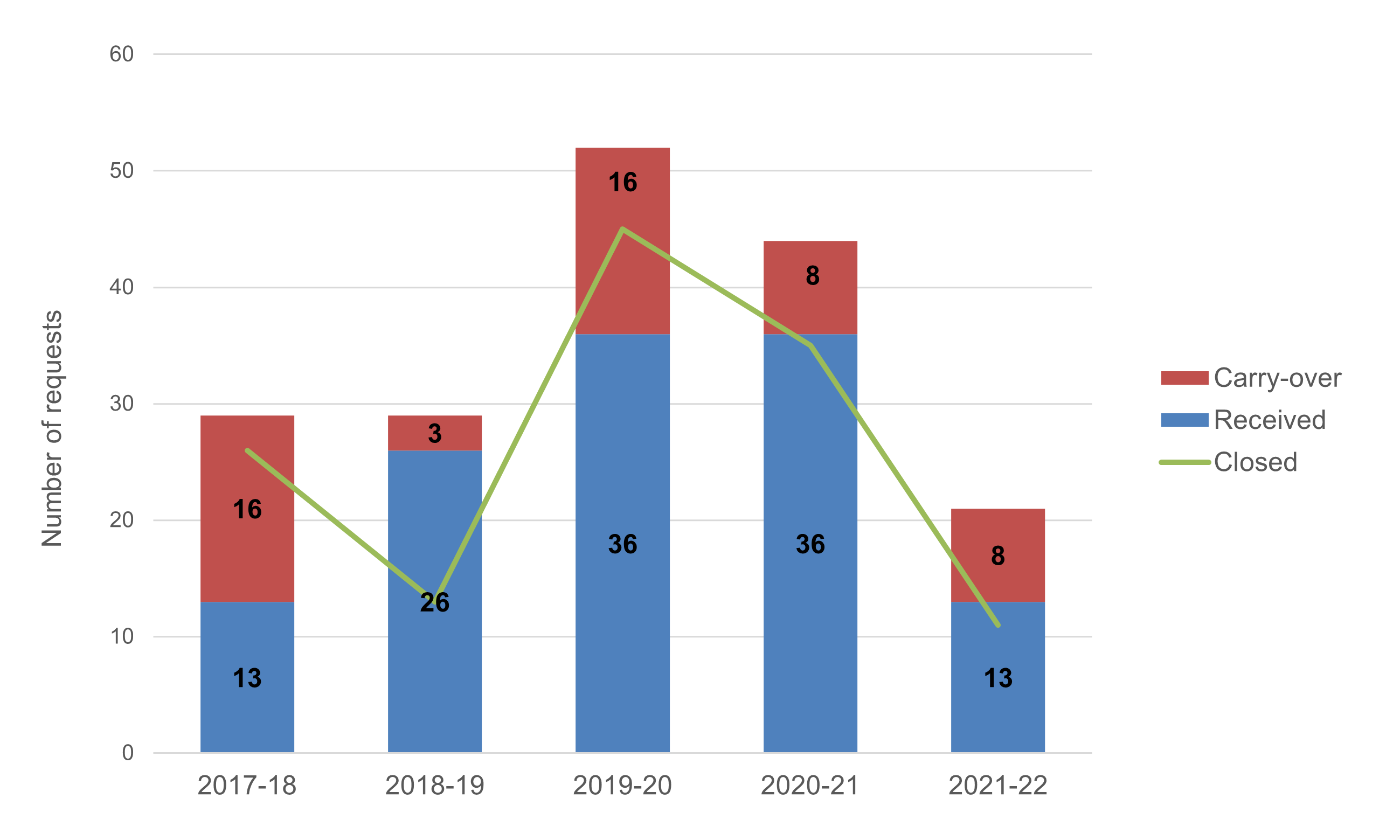
Number of requests carried over, received, and closed from 2017 to 2022 - Long Description
Fiscal year
Received
Carried-over
Closed
2017-18
13
16
26
2018-19
26
3
13
2019-20
36
16
45
2020-21
36
8
35
2021-22
13
8
11
In 2021-22, 2503 pages were carried over from fiscal year 2020-21 and 1213 pages were scanned for new requests for a total of 3716 pages. The number of pages processed and that resulted in closing the requests was 353.
Figure 2: Page count for ATI requests received and processed from 2017 to 2022
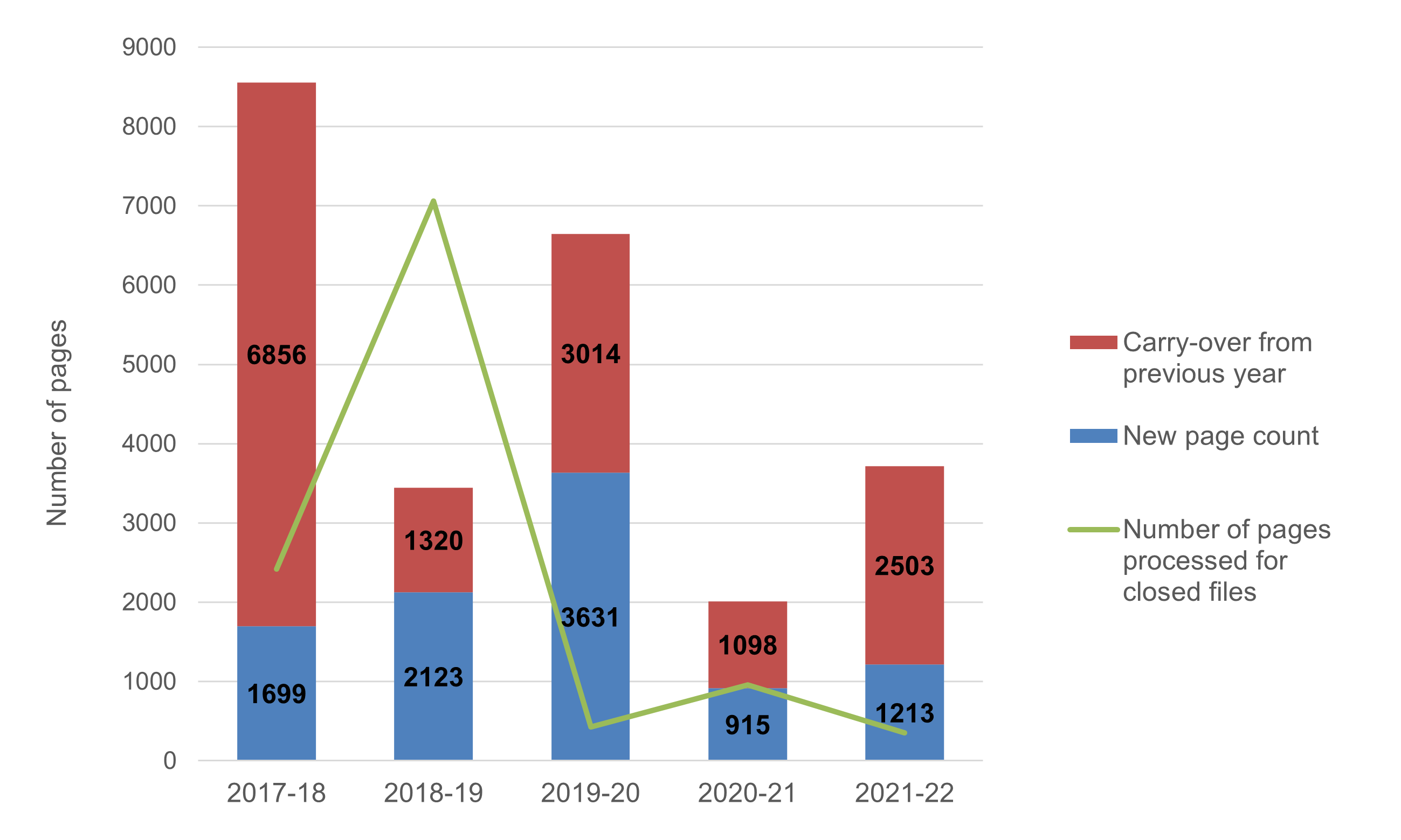
Page count for ATI requests received and processed from 2017 to 2022 - Long Description
Fiscal year
New page count
Carry-oever from previous year
Number of pages processed for closed files
2017-18
1699
6856
2417
2018-19
2123
1320
7058
2019-20
3631
3014
429
2020-21
915
1098
956
2021-22
1213
2503
353
4.2 Nature of Requests
ATI requests can target multiple programs and activities. The 13 new ATI requests received during this reporting period, were distributed across Offices of Primary Interest (OPIs) within NSERC. In total, the ATIP office initiated 10 taskings across the different divisions and directorates of NSERC. The distribution of tasking to OPIs can be found in Figure 3.
Figure 3: Assignment of ATI requests to Office of Primary Interest in 2021-22
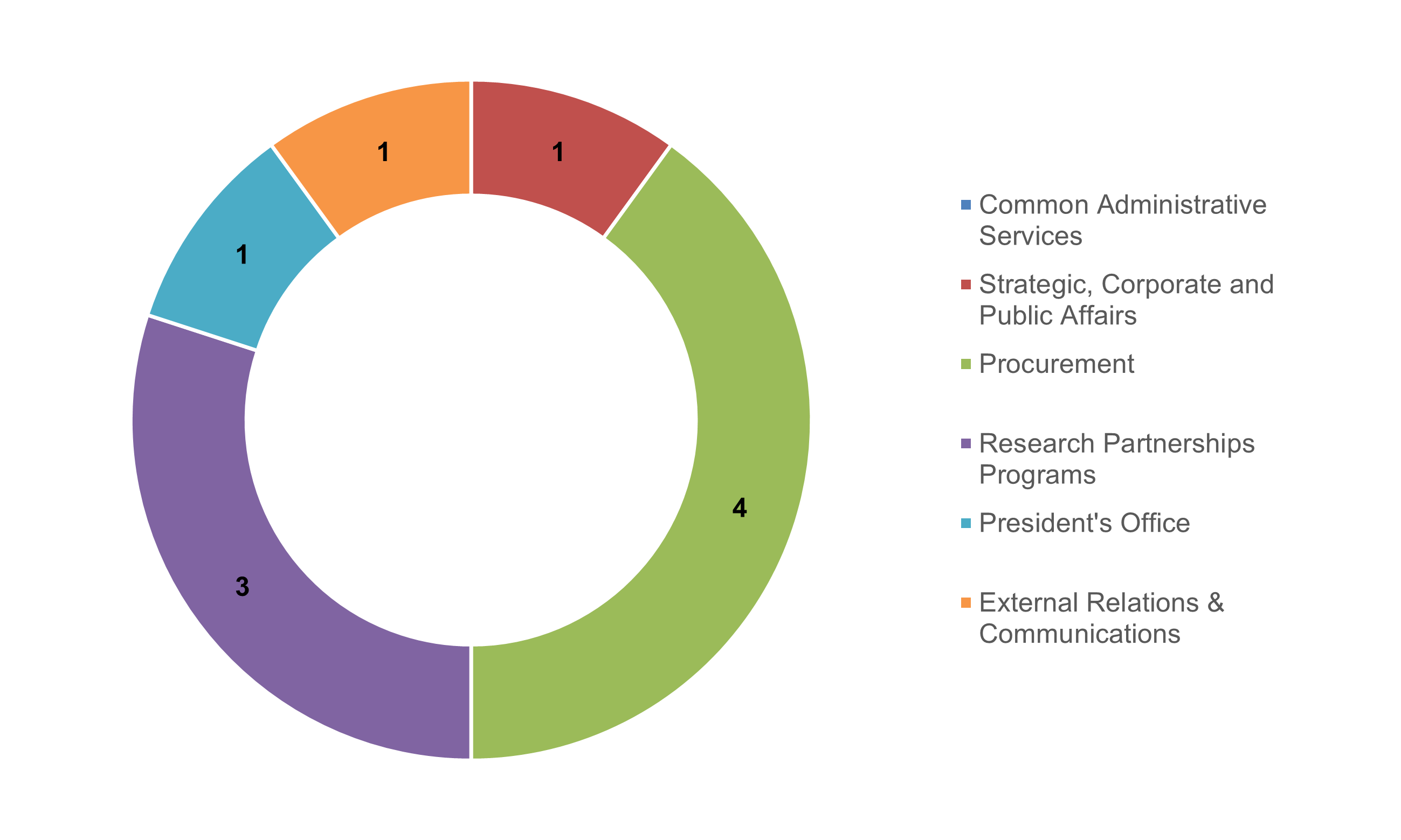
Assignment of ATI requests to Office of Primary Interest in 2021-22 - Long Description
Divisions and directorates of NSERC
Assignments to OPI
Common Administrative Services
0
Strategic, Corporate and Public Affairs
1
Procurement
4
Research Partnerships Programs
3
President's Office
1
External Relations & Communications
1
The sources of the 13 new ATI requests, received during the current reporting period, were distributed as follows:
Figure 4: Sources of ATI Requests received in 2021-22
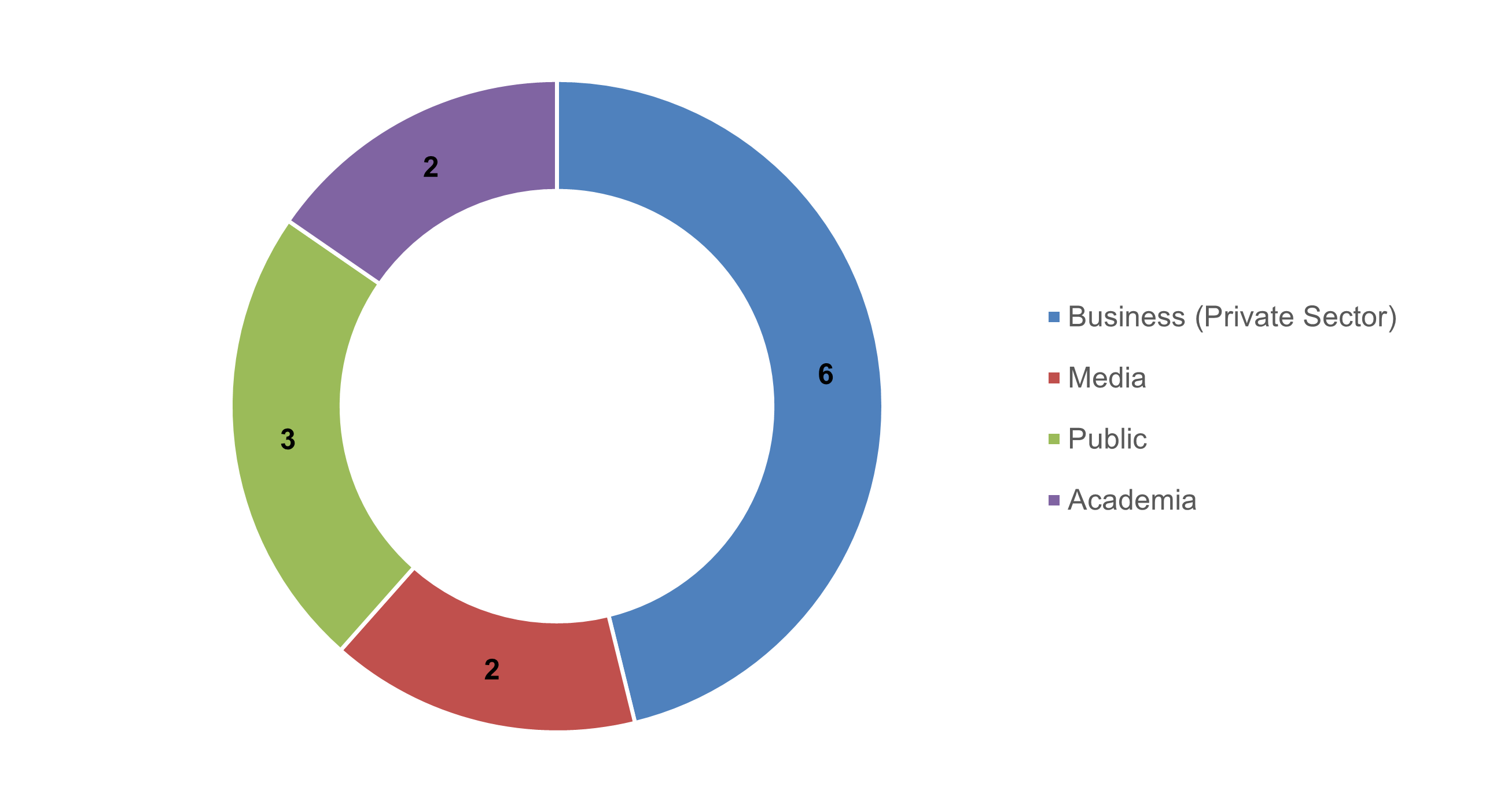
Sources of ATI Requests received in 2021-22 - Long Description
Source of ATI requests
Number of requests
Business (Private Sector)
6
Media
2
Public
3
Academia
2
4.3 Disposition of Requests Completed
Of the ATI requests processed during 2021-22, 11 were closed; a total of 353 pages were processed and 352 pages were released. Of the 11 closed requests, nine were disclosed in part and for two requests, no records existed.
Figure 5: Disposition of Completed ATI Requests 2021-22
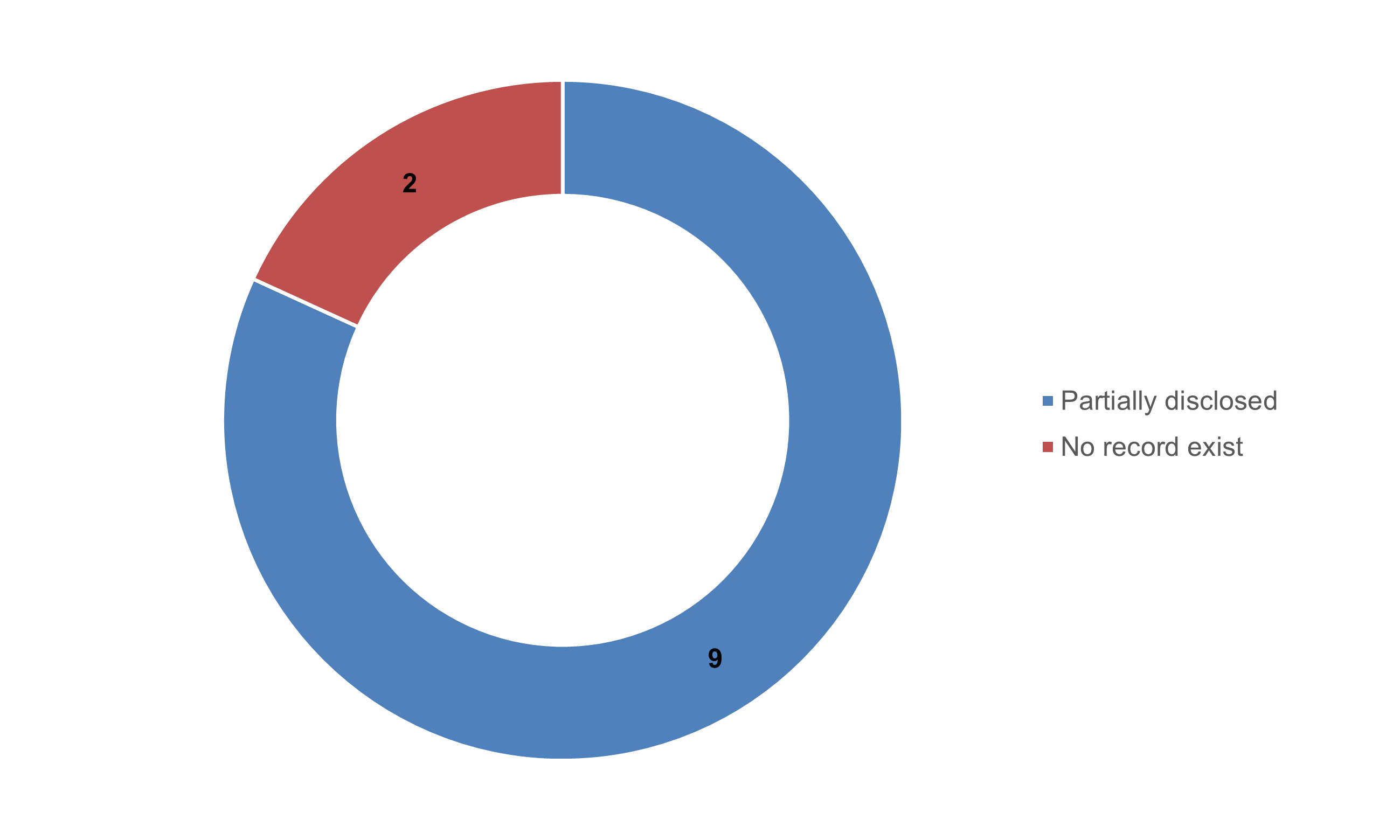
Disposition of Completed ATI Requests 2021-22 - Long Description
Disposition of requests
Number of requests
Partially disclosed
9
No record exist
2
4.4 Exemptions Invoked
For ATI requests where the information was disclosed in part, NSERC invoked one exemption under section 13 (1)(c) government of a province, one exemption under section 16 (2) security, six exemptions under section 19 (1) personal information, four exemptions under section 20 (1)(b) financial, commercial, scientific or technical information, four exemptions under section 20 (1)(c) information that could result in a financial loss and one exemption under section 21 (1)(a) plans or positions.
4.5 Exclusions Invoked
NSERC had zero exclusions invoked under section 69 (Cabinet Confidences) during the reporting period.
4.6 Completion Time
Two out of 11 ATI requests were closed within the initial 30-day period. The other nine were closed past the initial 30 days, and for seven of those requests, time limit extensions were taken. A time extension under section 9(1)(a) of the Access to Information Act was invoked for seven cases due to interference with operations, the requirement to conduct a large search and based on the high volume of records. Section 9(1)(b), consultations, was invoked for one case.
Figure 6: Completion time for ATI requests closed in 2021-22
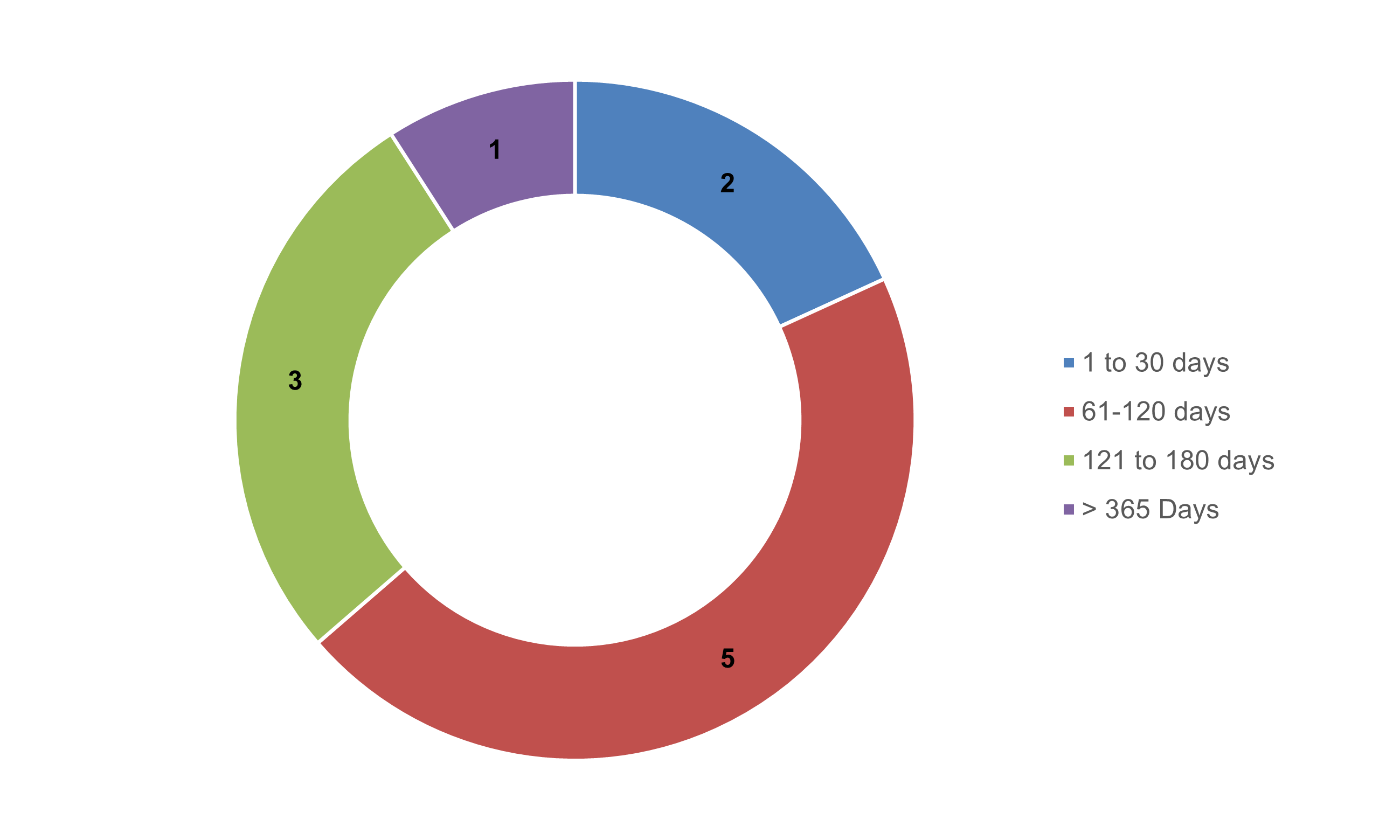
Completion time for ATI requests closed in 2021-22 - Long Description
Completion time
Number of requests
1 to 30 days
2
61-120 days
5
121 to 180 days
3
> 365 Days
1
Three responses were provided past the legislated deadline, two for which no extensions were taken and one for which an extension was taken because more time was needed given the complexity of request, the high volume of pages to be processed, and the waiting time for consultation responses. When extensions are factored in, NSERC responded to 72.72% of closed requests within the legislative timeline. This figure compares to 31.4% in 2020-21 and 84.4% in 2019-20.
4.7 Inter-Organizational ATI Consultations
NSERC received 21 new ATI consultation requests from other government departments and one external organizational ATI consultation. This is higher than the past three years, as shown in Figure 7.
Figure 7: Number of ATI consultation requests closed 2017-2022
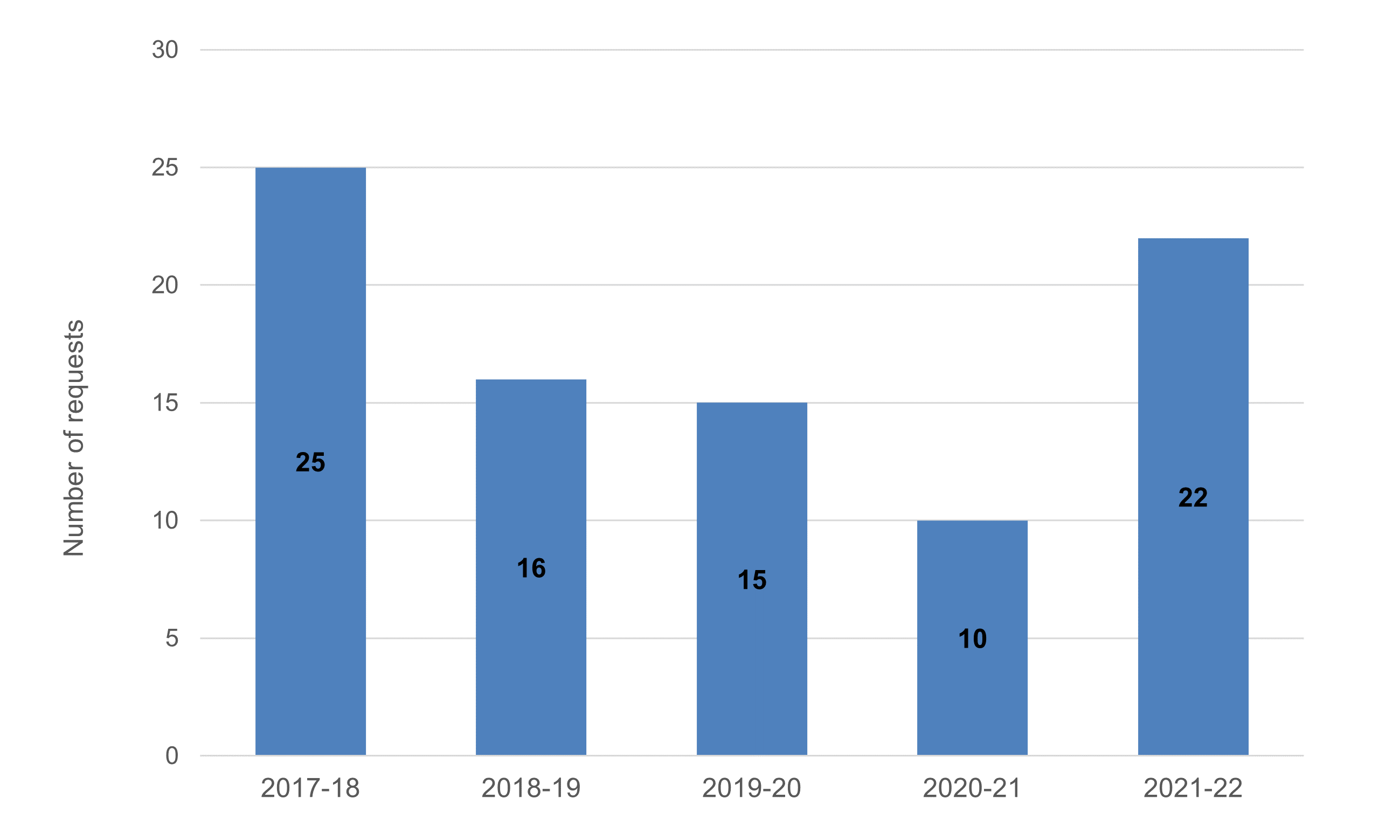
Number of ATI consultation requests closed 2017-2022 - Long Description
Fiscal year
Number of requests
2017-18
25
2018-19
16
2019-20
15
2020-21
10
2021-22
22
All of the 22 consultation requests NSERC received in 2021-22 were closed within the fiscal year. ATI consultation requests processed amounted to a total of 723 pages. This is significantly more than the four previous reporting periods (Figure 8). NSERC recommended disclosing partially for 10 ATI consultation requests and disclosing entirely for three requests. The "other" category captures cases where the given categories do not apply. More information can be found in Figure 9.
Figure 8: Number of pages processed for ATI consultation requests in 2021-22
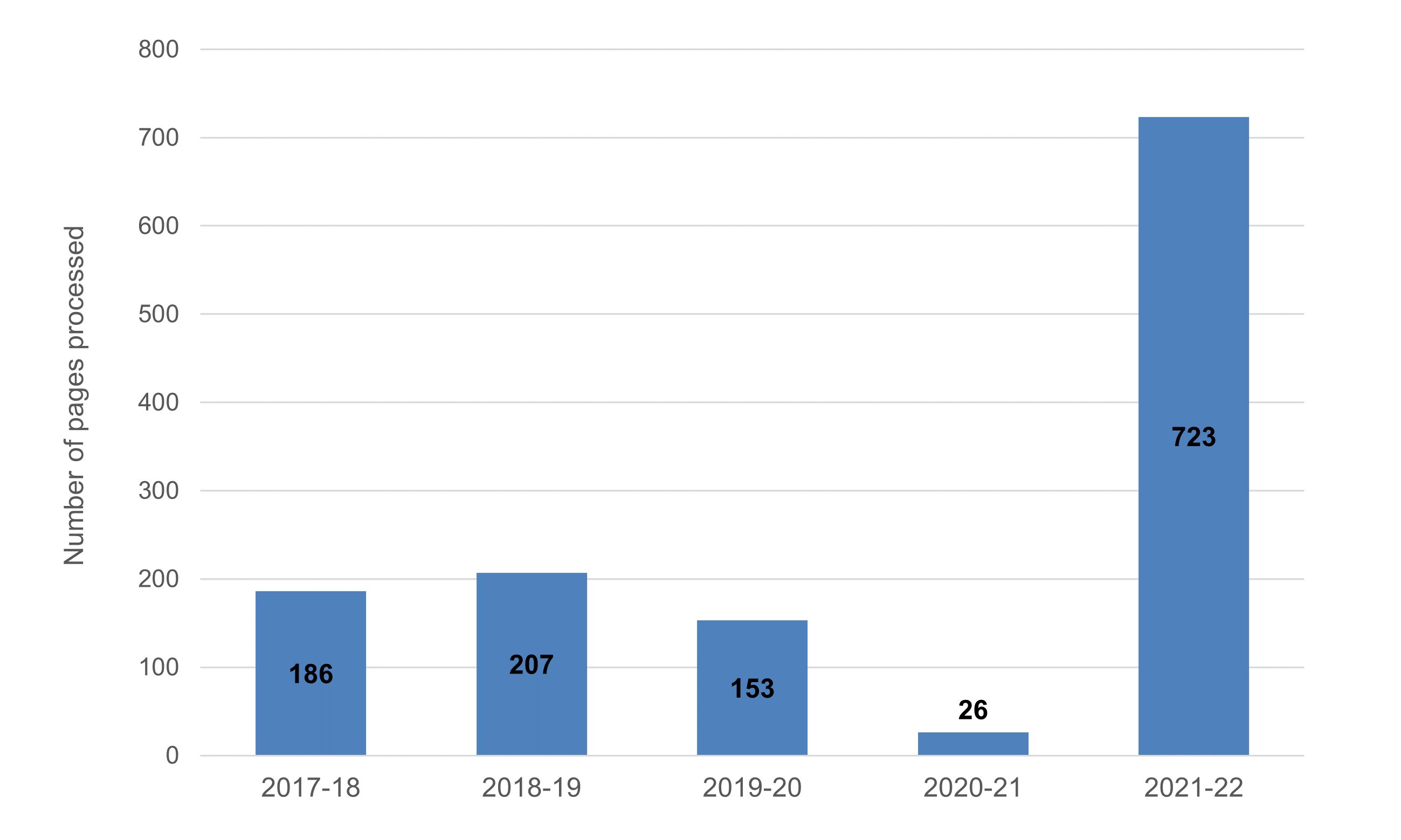
Number of pages processed for ATI consultation requests in 2021-22 - Long Description
Fiscal year
Pages processed
2017-18
186
2018-19
207
2019-20
153
2020-21
26
2021-22
723
Figure 9: Disposition of ATI consultation requests 2021-22
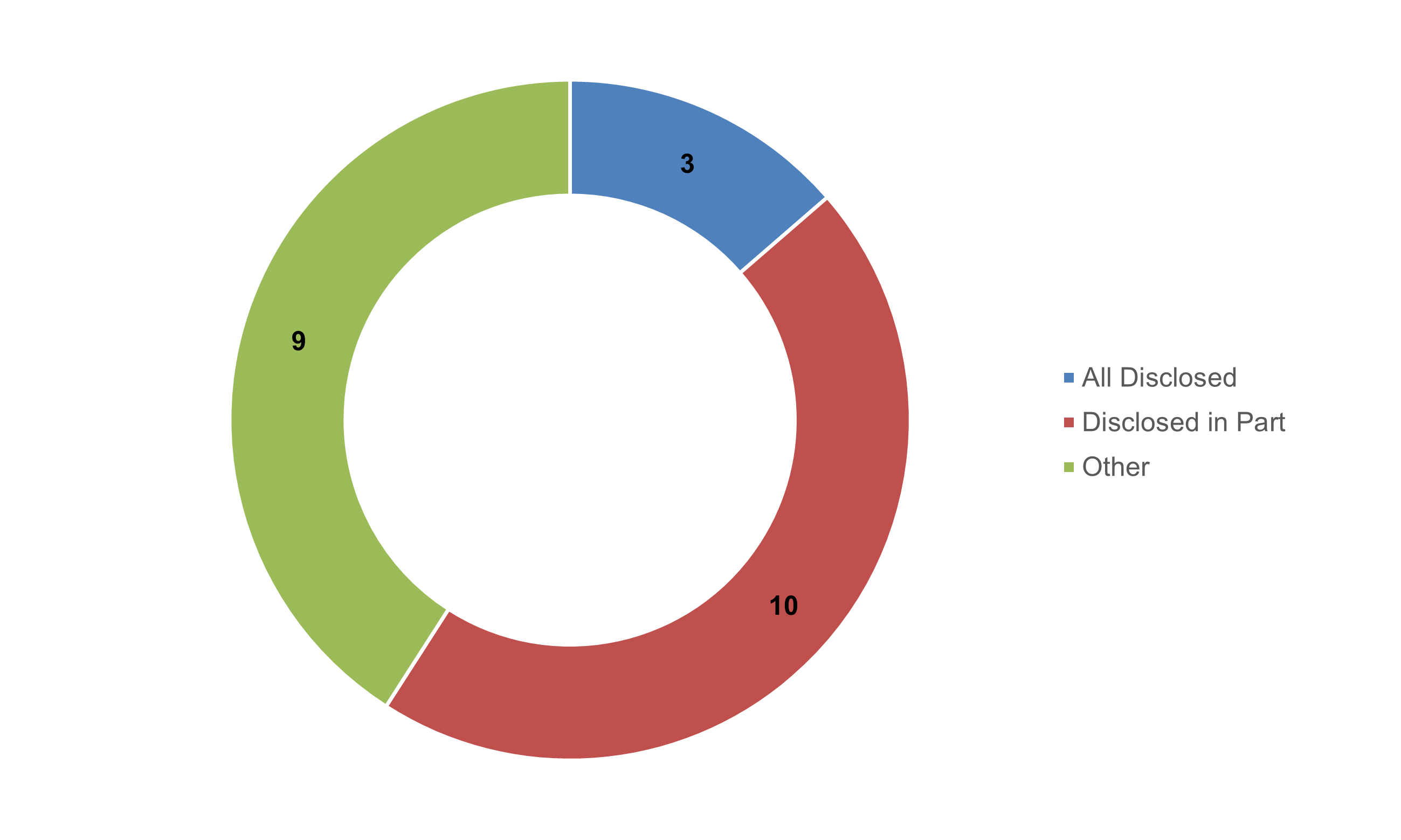
Disposition of ATI consultation requests 2021-22 - Long Description
Disposition of ATI consultation requests
Number of requests
All disclosed
3
Disclosed in part
10
Other
9
4.8 Impact of COVID-19
From April 1, 2021, to March 31, 2022, NSERC experienced operational challenges brought about by the COVID-19 pandemic. NSERC's access to information and privacy team continued to work from home during the full fiscal year. Early in the pandemic, NSERC's access to information and privacy team members did not have remote access to specialized access to information request processing software, and other resources available in the head office. The situation was resolved in 2021-22 but the backlog resulting from that disruption remained.
Even when full access to specialized ATIP software was available, the challenges of remote work added to the complexity of processing files, which impacted service delivery.
Remote work also led to an inability to process paper documents and secret documents. As of November 2021, the mailroom was able to receive protected records in paper format. In March 2022, NSERC launched a new extranet platform to provide requestors with their records securely and efficiently, rather than releasing large volume of records in a series of emails with password-protected PDF documents.
5. Services and Related Activities
Throughout the year, the ATIP Office provides advice and assists Agency staff by reviewing various documents such as answers to Parliamentary Questions, Privacy Protocols, Memoranda of Understanding, audits, evaluations, and security reports. The ATIP Office provided training on an as needed basis on the provisions of the ATI Act and its impact on NSERC programs and initiatives.
5.1 Info Source, Publicly Accessible Information, and Inquiry Points
Info Source: Sources of Federal Government and Employee Information provides information about the functions, programs, activities and related information holdings of government institutions subject to the Access to Information Act and the Privacy Act.
NSERC's funding policies, program descriptions, organizational structure and contact information can be found on its website. In accordance with the federal government's policy on proactive disclosure, evaluation and audit reports are also posted on NSERC's website. NSERC website's ATIP page provides background information on the Access to Information Act, and useful information about services provided.
NSERC also proactively discloses information on the federal government's Open Government website, such as: ATIP monthly summaries, information on awarded grants, contracts as well as travel, hospitality, and conference expenses.
5.2 Initiatives and Projects (completed or ongoing)
On June 21, 2019, Bill C-58 modified the Access to Information Act to require the publication of the title and reference number of each memorandum prepared by a government institution for the Deputy Head. In 2021-22, NSERC developed and implemented a new process for this requirement to improve efficiency and reduce administrative burden. NSERC continues to proactively publish briefing note titles each month within the allotted 30-day time limit.
5.3 Fees and Expenditures
The Service Fees Act requires a responsible authority to report annually to Parliament on the fees collected by the Institution. With respect to fees collected under the ATI Act, the information below is reported in accordance with the requirements of section 20 of the Service Fees Act.
- A $5.00 application fee is the only fee charged for an ATI request. The fees were collected for 13 requests for a total of $65.00.
- No fees were waived for the 2021-22 fiscal period.
In this year's reporting period, the total salary, goods, and professional services cost for the ATI program was $236,714. This figure represents an increase of over 7.9% compared to $219,448 in 2020-21 and is higher than the $174,947 in costs for 2019-20.
5.4 Challenges
In 2021-22, NSERC started the year with a carry-over of eight files from previous fiscal years. This situation, in addition to thirteen (13) new ATI requests to process, put pressure on NSERC's limited ATIP resources in the first half of the year. This required the ATIP team to establish operational priorities and to claim appropriate extensions of time. NSERC remained committed to assist requestors in refining their request, but ten (10) files were carried forward into the 2022-23 fiscal year, which is transferring the backlog issue into the cycle.
The ATI human resources utilized for this reporting period were estimated at 2.3 FTE, which is 35% more than 1.7 FTE reported for the 2020-21 fiscal year. Of this 2.3 FTE, 1.5 came from full-time employees, 0.7 from consultants and agency personnel, 0.1 from part-time/casual employees and students.
NSERC is facing continued difficulties in staffing ATIP positions but was able to staff two ATIP & Secretariat Officer positions and one ATIP Analyst position on a permanent basis. NSERC has made a commitment to build its internal ATIP team and expertise to increase stability and improve service delivery.
The complexity of ATI requests is high for records related to NSERC's grants. These records include detailed personal information (e.g., curriculum vitae) and confidential scientific, financial, and competitive information about applicants, their partners (such as R&D companies), and volunteer peer reviewers. Processing these requests required consultation with multiple third parties within and outside the Government of Canada (i.e., university/college professors, post-secondary institutions, corporate partners, etc.). Given the sensitive personal and competitive information held by NSERC and the diverse parties and interests involved, staff must be diligent to protect information, which if released, could harm the competitive advantage of an individual, institution, or company.
6. Complaints and Audits
6.1 Complaints
Requesters have the right to register a complaint with the Office of the Information Commissioner of Canada (OIC) regarding the processing of a request.
During the reporting period, there was one active complaint file initiated in 2021-22 which was considered resolved and closed in March 2022. Four outstanding complaints from the previous reporting period have been closed. There were no complaints carried over to 2022-23.
6.2 Audits
There were no audits conducted during the reporting period.